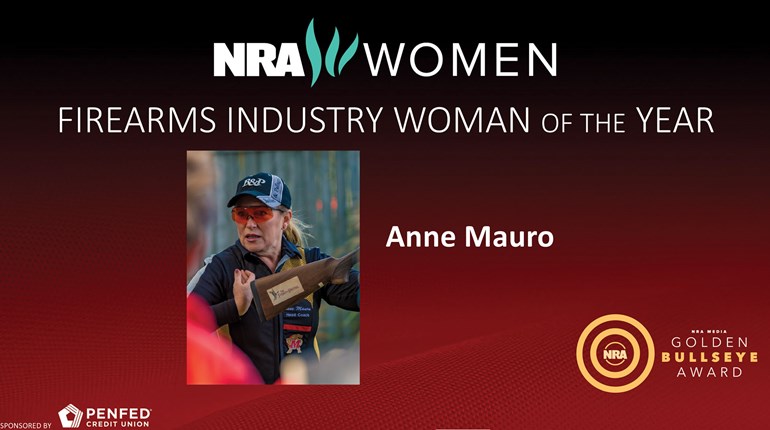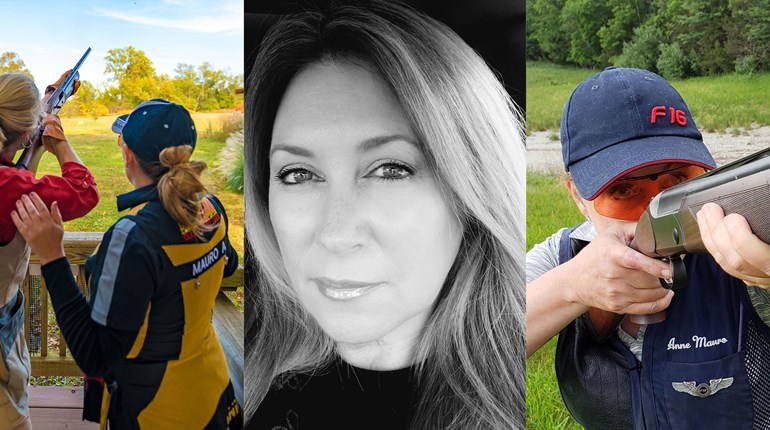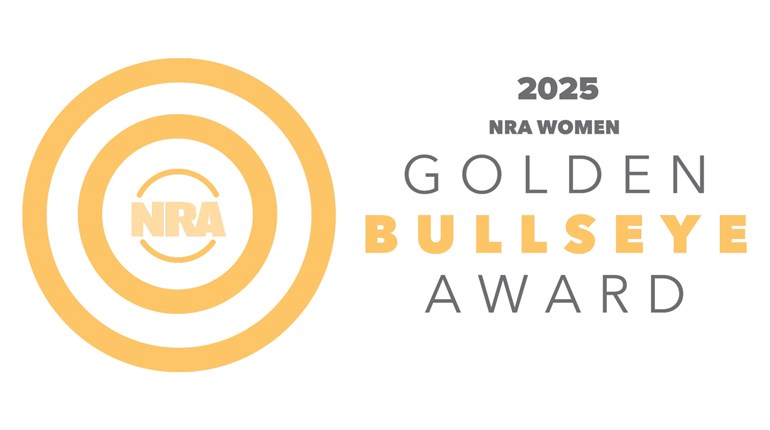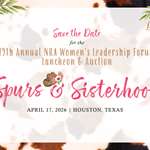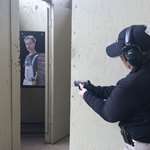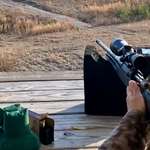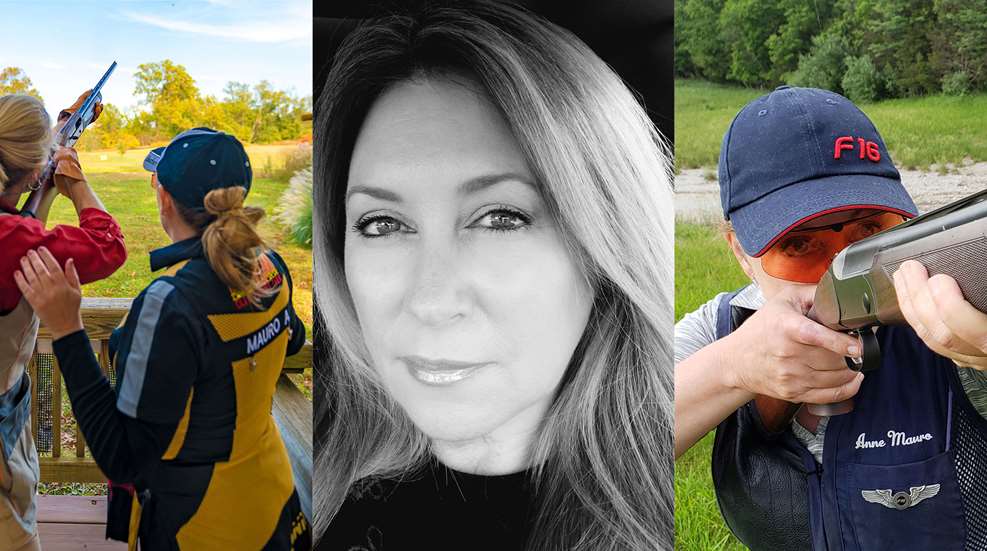
She may only stand at 5'2" tall, but as we've posted before, Coach Anne Mauro has become a giant in the world of shotgunning. In fact, chances are good that if you are a woman who has shopped for your first shotgun in the past 10 years, you have come across a design in which Mauro has had input. But Mauro would not have been able to effect change in an industry that has historically catered to a longtime male-dominated market unless she, too, had experienced the same trials and tribulations most women undergo when searching for a properly fitting shotgun: Too long, too heavy ... too everything to make pulling the trigger on hundreds of rounds on the clays course an appealing activity. The difference between most women who endured the requisite bruising and pounding and Anne Mauro is that Mauro didn't settle for the status quo, never accepting "that's just the way it is" in her relentless pursuit of an adequate shotgun for women. With an engineering background and a passion for the clays course, Mauro is now in high demand not only for her coaching prowess, but her expertise in how to design shotguns that women can shoot without going to the extra lengths she did to make her gun fit her diminutive stature.
Mauro's ability to coach on the clays field was gaining attention, and she was invited to be the first coach for the newly forming University of Maryland shotgun team. It is clear that Mauro's heart and soul lies with coaching, which has translated to an exponential increase in students pursuing the sport on the university's campus and beyond. In fact, Mauro has the distinction of achieving the title of NRA's Advanced Shotgun Coach Level III. Currently only 20 coaches in the United States hold this distinction—and only five are women..
For these reasons and more, NRA Women is extremely proud to present Coach Anne Mauro with the NRA Golden Bullseye Award for Industry Woman of the Year, as she has worked tirelessly, silently, humbly and often without public recognition for her outstanding contributions to the world of women and firearms. In this Q&A interview, learn more about the journey of this one-time engineer turned shotgun enthusiast, and why she has become an industry giant in the world of women and shotguns.

NRAW: Tell us how you got into the world of shotguns and competitive shooting. Was it intentional or an inadvertent second act? What did you do in your previous career?
AM: I always played sports competitively growing up. I was the executive director of education in my field working with federal, state and local agencies. My engineering background has always led me to seek knowledge and build it better. I was looking for a new sport to learn and my husband thought I would enjoy shooting sporting clays. Usually the husband/wife teaching thing never ends well, so I asked a local gun shop for references on an instructor, and they referred me to Ben Wise, who worked at Pintail Point [in Queenstown, Maryland]. I booked a lesson with Ben, who kept me safe and made it fun as I was learning. The rest is history, as one would say.
NRAW: Were you immediately aware that the equipment was not a good fit for you, or were you of the mindset that you had to adapt to the existing equipment?
AM: Standing barely 5’2” I was aware the shotgun didn’t fit but did my best to adapt even though it was a major struggle. I was learning how to hit a moving target and trying to get my cheek on the stock of a shotgun that was way too long, with a large grip for man hands, and could never get a solid fit of the buttstock into my shoulder pocket. I loved shooting clays from the moment I started. So as I continued to learn, I knew something had to change with the equipment. In my first attempt to make the range rental shotgun fit, I would have my instructor, Ben, take the buttpad off the stock to shorten the length. Yes, I shot bare wood the first eight months of learning. I would get bruised but didn’t care, as I loved learning to shoot clays. When the range sold their rentals for new inventory, I bought the 12-gauge Beretta 391 I had been renting. Ben then cut the stock down to fit me and added an adjuster plate. As I continued to learn he would adjust where we got it to fit well, minus the grip fit. After my first tournament I headed to Cole Fine Guns & Gunsmithing in Maine and had Rich Cole make me two stocks off those dimensions but now with a proper grip fit for me.
NRAW: What was the turning point for you when you decided you could help the industry make a better shotgun for women? (Or, who noticed your abilities to convey what a woman’s shotgun should be like?)
AM: The turning point came about when Caesar Guerini approached me about my shooting and thoughts on a shotgun for women. I showed them my shotguns and how things could be engineered for a woman with additional modifications. Other manufacturers had tried previously to create models for woman but lacked the understanding on how to succeed. As we designed and tested in different phases of the various models, the Caesar Guerini and Fabarm lineup progressed, Syren was established. Now came the fun task of getting the word out and letting women experience first-hand there were finally shotgun models available for them. I created events around the country showcasing the various models within the lineup.


I then moved on to engineer the Blaser F-16 Intuition Shotgun (right) and Blaser R-8 Rifle for women (above). What an amazing company and opportunity to expand the manufacturing offerings for woman. Again, it was back to the design and testing phases making additional tweaks along the way to develop these outstanding firearms that are available world-wide for women.
Many other manufacturers reached out as they designed their models for valuable input. Expanding the market offerings for women has been a major advantage for women. In addition to Caesar Guerini, Fabarm, and Blaser; Beretta, Franchi, Krieghoff, Perazzi, and Zoli, to name a few manufacturers, all produce models for women. Each offering specific design features to enhance the shooting experience. There will be two new models coming out in the future.
NRAW: Women are not all built alike. How did you go about the process of deciding what the average woman’s shotgun should be?
AM: Correct, women are not all built alike. I was certainly not going to design a shotgun that may fit just my body type. You must design based on averages that will fit a good majority. If we design based on those averages, we get a middle of the road starting point and a better fit out-of-the-box for a good majority of woman versus the standard fit out-of-the-box shotgun. This allows a much better fit from the start especially for those just starting versus the standard models we only had access to in the past. One learns quicker if the shotgun fits better from the start. Having a proper fitting grip is a major key, as well. If you design on the female body averages one can make additional modifications by shortening or lengthening a stock, change the cast and/or pitch based on the individual’s build. For some an out-of-the-box women’s model fits very well, some need to make slight modifications, and others based on experience level may want a custom fit shotgun, and for some the standard gun model may fit better with or without modifications. The beauty is there are now many models available in various price ranges for all shapes and sizes for woman. The goal in any development no matter if it is for a woman, man or youth is to have the best fit possible that keeps that individual comfortable and confident while out on the range shooting clays.
NRAW: Tell us about how you became the coach of the University of Maryland Clay Target Team—and what your coaching philosophy is, and anything else you would like to share about the team’s progression.
AM: I was approached by a few University of Maryland students at the time who were shooting informally at the Prince George’s County (MD) Trap, Skeet and Sporting Clays Center. They knew of me and my shooting and asked if I would help. I immediately said yes. There was no better way to give back up to my alma mater, help grow the sport and teach young adults about the Second Amendment. I created the University of Maryland Clay Target Team in 2011. My sole goal was to share a fantastic sport that these athletes could have for life all while supporting the Second Amendment. Anything they earned along the way as far as wins would be icing on the cake, and we have definitely iced a few cakes. Within their first year I led them to their first regional championship. Many other notable team wins and individual medals have followed to date. The University of Maryland is extremely proud and very supportive of the team. The teams over the years have had all levels of athletes, from those just learning to former National 4-H members. In addition to our support from UMD, we have wonderful sponsors and parental support. As their coach, I am always learning in my coaching and love the challenge to help each athlete to achieve their best ability in the moment.
NRAW: How did you become a coach?
AM: I first achieved my National Sporting Clays Association (NSCA) instructor certification. I was then approached by the NRA and USA Shooting to become part of their National Coach Development Staff. I continued with my training, achieving Advanced Shotgun Coach Level III. There are only 20 of us in the country who hold this distinction—and only five are women. When I was approached to train at the Olympic Training Center and Fort Carson in Colorado Springs, Colorado, I had no idea what I was getting into but headed out for the coaching certification. After I sat down in the classroom on the first day, I thought a terrible mistake had been made. I looked around the room and saw legends and was a bit taken back. During the first session break one of those legends came up to me, I express my disbelief I was chosen to be in this room. They had the same feeling about themselves and said they couldn’t believe they were in a room with me. We certainly had a good laugh. This was the most genuinely humble and highly selected group of coaches that could have ever been brought together. The training both in the classroom and on the range was beyond intense, testing our knowledge and limits all while forming bonding friendships. We all recognize that we are continually learning and accept that challenge every time we step on the range to train athletes.
One of the best things ever said to me in my coaching came from an Olympic athlete of another sport during dinner one evening. They had been observing me in my interactions with other athletes and thanked me for what I do and said I had something special that they rarely see in other coaches, “You have a true coach’s heart.” Those words had a profound impact on me then and still do to this day. I make every effort to continue my knowledge, share my knowledge and embrace this journey.

NRAW: What should gun manufacturers be doing more for women to encourage them to engage in the shooting sports?
AM: Keep up the great work. Woman and youth are the fastest growing demographics in the shooting sports. Many of the manufacturers have embraced the growth of woman within the sports and are making models with features that fit women better. It truly is wonderful to see the growth and models offered at all price points. One suggestion: Don’t name a model “Lady/Youth model”. Ladies don’t want to shoot a “Youth” labeled model and youth don’t want a “Ladies” model.
NRAW: Have you always been a Second Amendment supporter, or did that coincide with your introduction to shotgunning?
AM: My father instilled learning about the United States Constitution and all the rights it affords us as U.S. citizens. I grew up shooting pistols, so I have always been a supporter of the Second Amendment with a profound understanding and respect of what our Second Amendment right means.
NRAW: Tell us about your clinics that you have established at the National Sporting Clays Association National Championships in San Antonio. What is the goal and what is the response?
AM: I noticed years ago during the National Sporting Clays Association (NSCA) National Championships that most of the ladies would just ride around on the golf carts as their other family members competed. Many would stop me and say how they admired I was out there competing. I would tell these ladies, “If I can do this, so can you.” I approached NSCA if I could create and run a ladies clinic. They agreed, but said they didn’t think many would sign up. I said, “trust me; they will.” I designed out a great introduction program and recruited a few female competition shooters I knew would be great to help assist. This small program to start sold-out in its first year. That led me to expand the programming and location on the grounds over the years. This program has grown over the years into one of the highlighted sold-out events during the NSCA Nationals. I went from three cages on a practice course to now being in the National Shooting Complex stadium. In my quest to continue the growth for woman in the shooting sports, I have some exciting new programming coming up in 2025. Stay tuned.

NRAW: Why and how can we get more women involved in the shooting sports (whether it’s shotgun, handgun, hunting)? And as importantly—how do we get them to stay in the sport once they’ve tried it?
AM: The NRA offers exceptional programs for women with its Women On Target (WOT) programs. These events are held at ranges across the country and are led by very dedicated instructors, offering an introductory experience to women in the various shooting sports based on the club/range setup. Sometimes a woman will come back multiple times for the program to truly feel comfortable before she ventures off to the next level. That is perfectly fine and should be encouraged by anyone running these programs. If we can build confidence in someone at their pace they will stay with the sport.
The clubs/ranges will at times offer special ladies events. Every club/range that I have been to around the country, and it has been many of them, has been very supportive and welcoming of the women coming out to shoot.
There is also the National Shooting Sports Foundation First Shots program, and many ranges are offering their own learn-to-shoot programs that women can attend.
Seeing the need to allow women the opportunity to test their skills on the sporting clays course, I developed the NSCA Ladies Open, which is a 50-target tournament that takes place during the NSCA National Championships each year. This annual event has women of all shooting levels from beginners to advanced out competing and supporting each other.
There are many clubs/ranges and lady organizations around that country that offer ladies programming with specific discipline shooting leagues and hunting opportunities, as well.
If excellent quality programming is offered it will help ensure we keep women in the shooting sports.
NRAW: Is there anything else you want to accomplish in the realm of great-fitting guns for women?
AM: Absolutely! I have a design change that I believe will benefit even more woman. Everything takes time with development and testing. So, stay tuned.

NRAW: Tell us about any Second Amendment advocacy you are involved in, including with the NRA. Why should everybody, even if just want to shoot shotguns on the clays course, join the NRA?
AM: I am all about promoting the understanding of one’s Second Amendment right. It is beneficial to everyone who owns a firearm or even if you just rent when at the club/range to join the NRA. The NRA’s support and advocacy in protecting our gun rights is unwavering. The NRA also offers exceptional firearms education programming, community engagement events, product and service benefits and a choice of one of their many informative magazine publications. I encourage everyone I meet around the country if they are not a member to join the NRA today.
NRAW: Where can women go to find a good shotgun instructor?
AM: There are many great instructors available around the country. One can check her local range for references on local instructors; at times, visiting guest instructors will come in to teach at local ranges and one can take advantage of learning from them, if you travel to a destination club/range you can take lessons with great instructors to improve your skills and experience different teaching methods all while finding what suits you best.
NRAW: What else can you tell us about Anne Mauro that the world should know?
AM: The best is yet to come.












